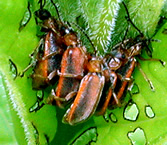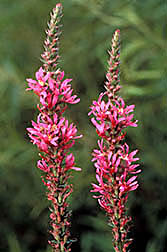This page has been archived and is being provided for reference purposes only. The page is no longer being updated, and therefore, links on the page may be invalid.
|
|
Chemical Communiqué of Weed-Attacking Beetle Deciphered
By Jan SuszkiwOctober 19, 2005
Monitoring beetle attacks on purple loosestrife could become easier to do now that Agricultural Research Service (ARS) scientists have discovered the beneficial insects' chemical attractant, or pheromone.
The leaf-eating beetles, Galerucella calmariensis and G. pusilla, were approved for U.S. release in 1992 as a biologically based means of controlling purple loosestrife, an exotic weed that degrades wetland habitats across North America. Chemical, mechanical and manual control methods can check small infestations. Larger ones, however, are a long-term fight perhaps best fought by Galerucella and other biocontrol agents.
Monitoring the beetles' population size and spread is critical to understanding their biocontrol success, notes entomologist Robert Bartelt, with ARS' National Center for Agricultural Utilization Research (NCAUR), Peoria, Ill. Starting in 2002, his team sought a chemical attractant that could lure the insects to traps for counting or relocation to new release sites.
Using a technique called electroantennographic detection, team member Allard Cossé saw the first hint of a pheromone from male G. calmariensis beetles. Obtaining enough pheromone for chemical analysis wasn't easy: over 1,000 collections of airborne chemicals from groups of live beetles—processed over 3 years by team member Bruce Zilkowski—yielded a mere 17 micrograms of pure pheromone.
Chemical analysis at NCAUR and elsewhere determined the pheromone to have a novel, dimethylfuran lactone structure. The team synthesized enough pheromone from commercially available chemicals to confirm its structure and to conduct initial field tests. In tests this past May, "sticky" traps containing the synthetic attractant captured 352 beetles, of both species and sexes, versus 64 for untreated traps, verifying the attractant's effectiveness.
Male Galerucella beetles release the pheromone compound while feeding on loosestrife—their only host plant—alerting others of food and mating opportunities. Somehow, the two species avoid competing with each other despite using the exact same pheromone, according to Bartelt. Next month, he'll give a poster presentation describing the research during an Entomological Society of America meeting in Fort Lauderdale, Fla.
ARS is the U.S. Department of Agriculture's chief in-house scientific research agency.



